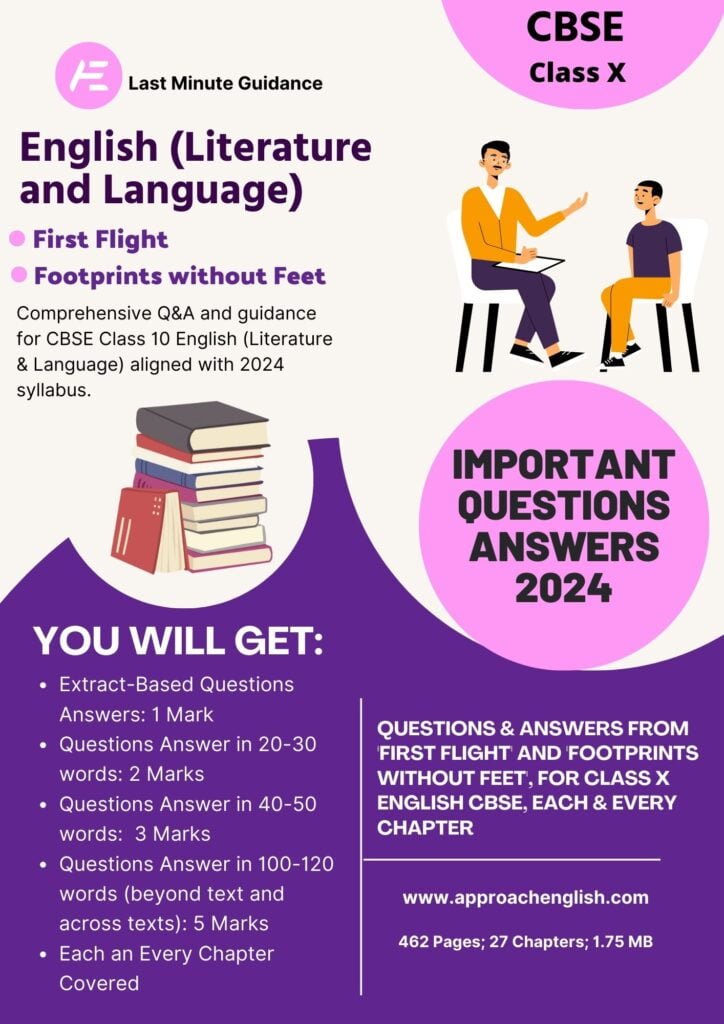A Baker from Goa Class 10 Questions and Answers have been prepared here according to the questions selected in the CBSE board English exam for class 10. This is a pen portrait of a baker or pader, who holds a significant role in Goan culture.
A Baker from Goa Class 10 Textual Questions and Answers
1 What are the elders in Goa nostalgic about?
Ans. The elders in Goa are nostalgic about the good old Portuguese days. They remember the loaves of bread made by Portuguese bakers.
2 Is bread-making still popular in Goa? How do you know?
Ans. Yes, bread-making is still popular in Goa. This is very clear from the narrator’s statement that the Portuguese have gone away but the traditional bakers and their furnaces are still exists in Goa. The mixers, moulders and the persons who bake the loaves still exist in Goa.
3 What is the baker called?
Ans. The baker is called pader in Goa.
CBSE Class 10 English (Literature and Language) Questions Answers pdf 2024
Suggestive Sample Question Answers Papers pdf 2024 for Class X English (First Flight and Footprints without Feet), tailored to the 2023-24 syllabus, serve as essential preparation material for the upcoming CBSE board exam, aiding students in comprehensive understanding and practice.

4 When would the baker come everyday? Why did the children run to meet him?
Ans. The baker would come twice a day, once early in the morning and the second time when he returned after selling all his bread. The children would run to meet him as they wanted bread-bangles, which they choose very carefully.
Oral Comprehension Check (Page 87)
1 Match the following. What is a must
(i) as marriage gifts? – cakes and bolinhas
(ii) for a party or a feast? – sweet bread called bol
(iii) for a daughter’s engagement? – bread
(iv) for Christmas? – sandwiches
People also ask
Ans: (i) as marriage gifts- sweet bread called bol
(ii) for a party or a feast-bread
(iii) for a daughter’s engagement – sandwiches
(iv) for Christmas – cakes and bolinhas
2 What did the bakers wear :
(i) in the Portuguese days?
(ii) when the author was young?
Ans. (i) The bakers usually wore a peculiar dress called Kabai. It was a single-piece long frock reaching down to the knees.
(ii) When the author was young, he saw the bakers wearing a shirt and trousers. The trousers were shorter than full-length and longer than half-pants.
3 Who invites the comment – “he is dressed like a pader?” Why?
Ans. Any person who is wearing a half pant which reaches just below the knees invites this comment. This is because the baker, known as pader, used to dress like that.
4 Where were the monthly accounts of the baker recorded?
Ans. The monthly accounts of the baker were recorded on some wall in the house with a pencil.
5 What does a ‘jackfruit-like appearance’ mean?
Ans. It means having a plump physique, like a jackfruit. was linked to the bakers because they had Such a physique and never starved. Baking was a profitable profession. The Baker and his family always looked happy and prosperous and had a jack fruit-like appearance.
Thinking About the Text (Page 88)
1 Which of these statements are correct? village in old times.
(1) The pader was an important person in the
(ii) Paders still exist in Goan villages,
(i) The paders went away with the Portuguese,
(iv) The paders continue to wear a single-piece long frock.
(v) Bread and cakes were an integral part of Goan life in the old days.
(vi) Traditional bread-baking is still a very profitable business.
(vii) Paders and their families starve in the present times.
Ans. (i) Correct
(iii) Incorrect
(v) Correct
(vii) Incorrect
(ii) Correct
(iv) Incorrect
(vi) Correct
Related topics
| A Baker from Goa Class 10 Questions Answers |
| Coorg Class 10 Questions Answers |
| Tea from Assam Class 10 Questions and Answers |
2 Is bread an important part of Goan life? How do you know this?
Ans. Yes, bread is an important part of Goan life. We know this as it is needed for marriage gifts, parties and feasts. Bread is needed by a mother for preparing sandwiches during her daughter’s engagement. Cakes and bolinhas are essential for Christmas and other festivals.
(i) The thud and the jingle of the traditional baker’s bamboo can still be heard in some places. (nostalgic, hopeful, sad)
(ii) Maybe the father is not alive but the son still carries on the family profession. (nostalgic, hopeful, sad)
(iii) I still recall the typical fragrance of those loaves. (nostalgic, hopeful, naughty)
(iv) The tiger never brushed his teeth. Hot tea could wash and clean up everything so nicely, after all. (naughty, angry, funny)
(v) Cakes and bolinhas are a must for Christmas as well as other festivals. (sad, hopeful, matter-of-fact)
(vi) The baker and his family never starved. They always looked happy and prosperous. (matter-of-fact, hopeful, sad)
Ans. (i) Nostalgic
(iii) Nostalgic
(v) Matter-of-fact
(ii) Hopeful
(iv) Funny
(vi) Matter-of-fact
Q3 A Baker from Goa Class 10 Multiple Choice Questions and Answers Extract Based 1
Read the following extracts carefully and answer the questions that follow.
(A) The baker made his musical entry c scene with the ‘jhang jhang’ sound of the specially made bamboo staff. One hand supported the basket on his head and the other banged the bamboo on the ground. He would greet the lady of the house with ‘Good Morning’ and then place his basket on the vertical bamboo. We kids would be pushed aside with a mild rebuke and the loaves would be delivered to the servant. But we would not give up. We would climb a bench or the parapet and peep into the basket, somehow.
(i) How would the baker greet the lady of the house?
(a) With Good Evening
(b) With Good Morning
(c) With a Bow
(d) With a Smile
(ii) Choose the option that lists the set of statements that are NOT TRUE according to the given extract.
1. The baker was a celebrated individual.
2. The children loved the loaves of bread.
3. The baker was very rude.
4. Only the servant would address the baker.
5. The baker entered with a musical sound.
6. The baker carried the loaves of bread in a box.
(a) 1,2 and 4
(c) 1,3 and 5
(b) 2,5 and 6
(d) 3,4 and 6
(iii) What did the baker do first once he reached a house?
(a) Place the basket and deliver the loaves.
(b) Place the basket on the vertical bamboo and deliver the loaves to the servant.
(c) Deliver the loaves to the lady of the house.
(d) None of the above
(iv) Why would the children not give up?
(a) Peeping into the basket.
(b) Crying to peep into the basket.
(c) Finding other ways to peep into the basket.
(d) Pushing aside others to peep into the basket.
(v) Pick the option that correctly classifies Fact/s (F) and Opinion/s (O) of the students below.
(1) The baker must be a central figure in Goa.
(2) Bread was a necessity in those times.
(3) I think carrying the bread on a basket would be unhygienic.
(4) The loaves of bread must be very tasty.
(a) F- 1,2 and O-3,4
(b) F- 1,4 and 0-2,3
(c) F- 2,3 and O- 1,4
(d) F- 1,3 and O-2,4
Ans: (i) (b) With Good Morning
(ii) (d) 3,4 and 6
(ii) (b) Place the basket on the vertical bamboo and deliver the loaves to the servant.
(iv) (c) Finding other ways to peep into the basket.
(v) (b) F- 1,4 and O-2,3
A Baker from Goa Class 10 Multiple Choice Questions and Answers Extract Based 2
Read the following extracts carefully and answer the questions that follow.
(B) Monthly accounts used to be recorded on some wall in pencil. Baking was indeed a profitable profession in the old days. The baker and his family never starved. He, his family, and his servants always looked happy and prosperous. Their plump physique was an open testimony to this.
(a) Arup Kumar Dutta
(b) Lokesh Abrol
(c) Lucio Rodrigues
(d) None of these
(ii) Which profession was a profitable one in old days?
(a) Cooking
(b) Baking
(c) Accounting
(d) Teaching
(iii) Monthly records used to be recorded on
(a) notebook
(c) walls
(b) paper
(d) computers
(iv) What gives a testimony to the statement according to which baking was a profitable profession?
(b) Their plump
(a) Their happiness physique
(c) Their prosperity
(d) All of the above
(v) Pick the option that correctly classifies Facts (F) and Opinions (O) of the students below.
(1) I think baking was a profitable profession in the old days.
(2) I think baking as a job was not gainful for the baker’s family.
(3) I think bakers used to be very prosperous.
(4) I think bakers have been universally acknowledged.
(a) F- 1,3 and O-2,4
(b) F- 2,4 and O- 1,3
(c) F- 1,2 and O-3,4
(d) F-3 and O-1,2,4
Ans. (i) (c) Lucio Rodrigues
(ii) (b) Baking
(iii) (c) walls
(iv) (d) All of the above
(v) (a) F- 1, 3 and O-2, 4
Q10 A Baker from Goa Class 10 Questions and Answers in 20-30 words
1. Why was the baker’s furnace essential in a traditional Goan village? CBSE 2010
Ans. The baker’s furnace was essential in a traditional Goan village because different kinds of breads were required for different occasions. Marriage gifts are meaningless without the sweet bread known as bol. The lady of the house must prepare sandwiches on the occasion of her daughter’s engagement. Cakes and bolinhas are essential for Christmas as well as other festivals.
2. How do we know that Goa’s bakers are very prosperous CBSE 2019
Ans. We know that Goa’s bakers are very prosperous from their plump physique. Baking in Goa is an i profession as breads were an essential part of all festivities in Goa. As a result, the baker, his family and servants never starved. They were always happy.
Q12 A Baker from Goa Class 10 Questions and Answers in 100-120 words (beyond text and across texts)
1 After reading the story A Baker from Goa’, do you think our traditions, heritage, values and practices are the roots that nourish us? Why/why not? CBSE 2015
Ans. Traditions, heritage, values, and practices are essential for nourishing our personalities, providing emotional support, mental strength, and influencing societal behavior. In Goa, bread is a crucial aspect of every occasion, with marriages and festivals incomplete without a sweet bread called ‘bol’. Even today, elders remember the famous Portuguese breads baked by Portuguese bakers, demonstrating the importance of bread in Goan life. These traditions keep our past heritage alive and nourish us, making bread an essential part of Goan life.
2. Why were the children fascinated by the baker? How did they show their eagerness to see him? CBSE 2020
Ans. The narrator of the chapter ‘A Baker from Goa’ while talking about the traditional Portuguese bakers of Goa states that he along with the other children
was fascinated by the baker as the baker was their friend, companion and guide. They would always look at him whenever he used to come across their street in a day.
The children according to the narrator, were eager to see him. They used to wake up whenever they heard the jingling sound of the bakers’s bamboo stick. Whenever the baker greeted the lady of the house, they would surround the baker who would rebuke them and hand over the loaves to a servant. Then, the children would limb over a chair to peep into the basket full of bread loaves. These children didn’t even brush their teeth before taking the bread bangles that they could choose carefully.
Their actions made it clear that the children were fascinated by the baker and were always eager to see him.
Extra A Baker from Goa Class 10 Questions and Answers
1. What is called baker in Goa?
Ans: In Goa, a baker is often referred to as a “pader.” The tradition of the Goan baker, known as the “poder,” involves delivering freshly baked traditional Goan bread, such as pão (bread), to homes in local neighborhoods. The term “pader” or “poder” is commonly used to denote these bakers in Goa.
2. What is the role of a baker in a Goan village Class 10?
Ans: In a Goan village, the role of a baker, known as a “poder” or “pader,” is significant. The baker bakes and delivers traditional Goan bread, particularly pão, to households, a staple in Goan cuisine. The bread is baked in a wood-fired oven, starting early in the morning and shaping to perfection. The baker also plays a social role in the community, engaging with villagers during bread deliveries. Their arrival with fresh bread is not just a transaction but also a social exchange, fostering a sense of community and tradition within the village. In essence, the baker in a Goan village contributes to the social fabric, connecting people through a shared culinary tradition.
3. What did the Portuguese love Class 10?
Ans: During their colonial rule, the Portuguese valued exploration, trade, religious conversion, architecture, cuisine, cultural exchange, and education. They were pioneers in exploring new routes, promoting Christianity, and constructing churches and cathedrals. Portuguese cuisine, blending spices, seafood, and techniques, was influential in the colonies. They engaged in cultural exchanges, influencing local traditions and languages, and adopted aspects of local cultures. Additionally, they supported the development of education in their colonies through the establishment of schools and the dissemination of knowledge.
4. What is the main point of the baker from Goa?
Ans: The primary role of the baker, known as the “poder” or “pader,” from Goa is to bake and deliver traditional Goan bread, particularly the crusty, fluffy loaf known as pão, to households in the village. Beyond simply providing bread, the baker plays a significant social role, fostering a sense of community by engaging with villagers during the bread deliveries and becoming a familiar figure in the neighborhood. The baker’s arrival with freshly baked bread isn’t just a transaction but also a social exchange that contributes to the fabric of the local community in Goa.
5. Which name is used for the sweet bread?
Ans: The sweet bread in Goa is commonly known as “sannas.” Sannas are a type of sweet, steamed bread that is a popular delicacy in Goan cuisine. They are often served as a snack or with savory dishes and are enjoyed for their soft, fluffy texture and mildly sweet taste.
6. What is the character sketch of the baker?
Ans: A Goan baker is a hardworking, dedicated individual who starts their work early in the morning, dedicating hours to baking fresh bread for the community. They are a cultural custodian, preserving traditional Goan bread and preserving the region’s culinary heritage. They are community-focused, interacting with villagers during bread deliveries, fostering a sense of community. Bakers are skilled craftsmen, ensuring quality and taste in their work. They symbolize continuity, routine, and reliability in the village, and serve as cultural ambassadors, sharing the richness of Goan culinary traditions.
7. What type of man was the baker?
Ans: In Goan culture, bakers were hardworking, reliable, and community-oriented individuals known for their dedication to their craft. They prepared and baked traditional Goan bread, like pão or sannas, early in the morning. These bakers played a significant social role within the community, fostering a sense of continuity, stability, and reliability. Their presence and interaction were integral to village life.
8. How did the baker known as Pader announce his arrival?
Ans: The baker, known as “pader” in Goa, traditionally announced his arrival by blowing a horn or a whistle as he moved through the village streets. This distinctive sound served as a signal to the villagers, indicating that the fresh batch of bread, such as pão, was ready and available for delivery. The unique sound of the horn or whistle was a customary way for the baker to alert the residents of his presence and the availability of freshly baked bread for purchase.
9. How did the baker attract the children in Goa?
Ans: In Goa, the baker, known as the “poder” or “pader,” attracts children with a recognizable call or song, creating anticipation and joy. The lively tune, combined with the excitement of freshly baked bread, adds a cheerful and communal aspect to the daily routine of bread delivery in Goan villages.
10. Who did people in Goa look at the baker?
Ans: In Goa, the baker, also known as the “poder” or “pader,” was a respected community figure, preserving traditional Goan bread, passing down cultural heritage, and fostering community bonds. They served as cultural ambassadors, showcasing Goan culinary traditions.
11. Is a baker from Goa a nostalgic saga?
Ans: The Goa baker, known as the “poder” or “pader,” is a symbol of nostalgia and community involvement. His traditional bread-making routine, including wood-fired ovens, unique announcements, and communal interactions with villagers, particularly children, evokes fond memories of a simpler time and a connection to the community’s cultural heritage. This portrayal of the baker and traditional baking practices in Goa is a nostalgic saga.
12. How do elders in Goa remember a baker?
Ans: Goa elders value the baker, also known as the “poder” or “pader,” for their cultural heritage, traditional bread-making process, unique aromas, community involvement, and daily fresh bread provision, symbolizing shared experiences and cultural identity.
13. Who wrote baker from Goa about?
Ans: Goan traditional writings explore the baker, known as the “poder” or “pader,” and their cultural significance, historical context, and social interactions. These writings aim to capture the baker’s role in preserving traditions, fostering community bonds, and contributing to Goa’s cultural heritage. They can be found in literature, historical accounts, cultural studies, and personal experiences
14. Who is the bread bangles baker from Goa?
Ans: The term “bread bangles baker” may refer to a local Goan artisan specializing in making unique bread bangles, typically smaller and consumed as snacks or accompaniments to tea or coffee. However, the term may be regional or specific to specific Goan areas, making it difficult to identify a dedicated baker for this particular type of bread.
15. Who introduced bakery in Goa?
Ans: Portuguese colonial rule in Goa significantly influenced the region, introducing various culinary traditions and baking techniques. Bakeries emerged, blending European baking methods with local flavors. The Portuguese introduced ingredients, styles, and recipes, creating a unique Goan bakery culture that continues to thrive today.
16. What is the culture of Goa?
Ans: The culture of Goa is a vibrant and diverse mix influenced by various historical, social, and religious factors. Here are some aspects that contribute to the rich cultural tapestry of Goa.
17. What is poder in Goa?
Ans: In Goa, the term “poder” refers to the traditional bread baker who delivers fresh bread, like pão, to households in villages. They play a crucial role in the community, providing fresh bread daily and contributing to the region’s cultural heritage.
18. Why Goa is called?
Ans: The name “Goa” is believed to have originated from the Sanskrit word “Gomantak,” meaning “land of the Gods,” or from the Mahabharata, where it is referred to as “Goparashtra” or “cow-land.”
19. What is Goa name for?
Ans: “Goa”‘s origins are believed to be derived from Sanskrit words like “Gomantak” or “Goparashtra,” meaning “land of the Gods,” or local linguistic or cultural references highlighting its divine or fertile nature.
20. What Goa is famous for?
Ans: Goa, India’s state, is known for its stunning beaches along the Arabian Sea coast, rich cultural heritage influenced by Portuguese colonization, and beautiful historical architecture. The city is also known for its vibrant nightlife, offering clubs, beach parties, and live music events. Water sports enthusiasts can enjoy parasailing, jet-skiing, windsurfing, and banana boat rides. Flea markets and wildlife sanctuaries, such as Bhagwan Mahavir Wildlife Sanctuary and Mollem National Park, provide shopping opportunities. Goa hosts various festivals throughout the year, attracting tourists from around the world.
Related Search







